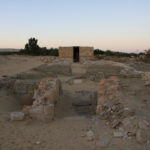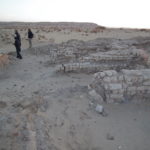QAṢR AL-MIQĪṢBA (POKA)
| Greek | Ποκα |
| Arabic | العين التبنية | قصر المقيصبة |
| English | Qasr el-Megisba | Qasr el-Megysbeh | Meguesbeh | el-Megysbah | El-'Ain et-Tibniya | Ayn el-Tibaniya | El-Tebanieh |
| French | Kasr Magasba |
| DEChriM ID | 21 |
| Trismegistos GeoID | 3168 |
| Pleiades ID | 716628 | PAThs ID | - |
| Ancient name | Poka |
| Modern name | Qaṣr al-Miqīṣba |
| Latitude | 28.342029 |
| Longitude | 28.822359 |
| Date from | - |
| Date to | - |
| Typology | Village |
| Dating criteria | - |
| Description | Qaṣr al-Miqīṣba, known as Poka in antiquity, is located approximately 5km from Psôbthis, the ancient metropolis of Baḥariyya, which is today covered by Qaṣr al-Bāwīṭī. The site comprises a large temple complex of some 45 rooms dedicated to Amenre and Horus, built in the reign of Alexander the Great (Fakhry 1950: 42, 46). Analysis of the ceramic assemblages and coins has provided a chronology of occupation, dating from at least the Ptolemaic times, until the last Fatimid century (Fakhry 1950: 42, 47; Colin, Laisney and Merchand 2000: 155). A great number of Coptic and Greek ostraca were uncovered by Fakhry, documenting the presence of a Christian community at the site from at least 370 (Ghica 2012: 249). As with many other sites, such as Dūš, the Christian markers are mostly limited to anthroponyms and mention of ecclesiastical functions (Ghica 2012: 249; O.Bahria 6 & 10). |
| Archaeological research | The site appears to have gone unnoticed by most of the early travelers, first being mentioned by John Gardner Wilkinson, who visited the temple in 1825, followed by Paul Ascherson, who visited the site in 1874. This was followed by the work of J. Ball and H. Beadnell, who unfortunately only mapped the area, without additional comments. The first somewhat systematic exploration of the archeological remains was conducted by the Egyptologist Ahmed Fakhry, cleaning the site in 1938, making a plan in 1939, and completing excavations in 1942. Two recent IFAO missions have identified a church and a monastery in the hinterlands of Psôbthis, strengthening evidence of the Christian community of the area in antiquity (Ghica 2012: 250). |
- Ascherson, P. 1885. “Comments on the map of my trip to the Small Oasis in the Libyan Desert.” In Zeitschrift der Gesellschaft für Erdkunde zu Berlin 20: 142.
- Colin F., D. Laisney and S. Marchand. 2000. “Qaret el-Toub: un fort romain et une nécropole pharaonique. Prospection archéologique dans l’oasis de Baḥariya 1999.” Bulletin de l’Institut français d’archéologie orientale 100: 145-192.
- Fakhry, A. 1950. The Egyptian Deserts: Baḥria Oasis, vol. 2. Cairo: Government Press.
- Ghica, Victor. 2012. “Pour une histoire du christianisme dans le désert Occidental d’Égypte.” Journal des Savants 2: 249-250.
- Ghica, Victor. 2016. “Vecteurs de la christianisation de l’Égypte au IVe siècle à la lumière des sources archéologiques.” In Acta XVI Congressus Internationalis Archaeologiae Christianae, Rome 22-28.9.2013, edited by Olof Brandt and Gabriele Castiglia, 240. Città del Vaticano: Pontificio Istituto di Archeologia Cristiana.
- Labrique, F. 2013. “Lieux et épiclèses locales à Bahariya. D’après l’épigraphie monumentale d’èpoque tardive.” In Bahariya Oasis. Recent Research into the Past of an Egyptian Oasis, edited by M. Dospěl and L. Suková, 258, 260, 265-6. Prague: Charles University.
- Wilkinson, G. 1843. Modern Egypt and Thebes: Being a Description of Egypt, Including Information Required for Travelers in that Country, vol. II, 357. London: J. Murray.


 Json data
Json data







